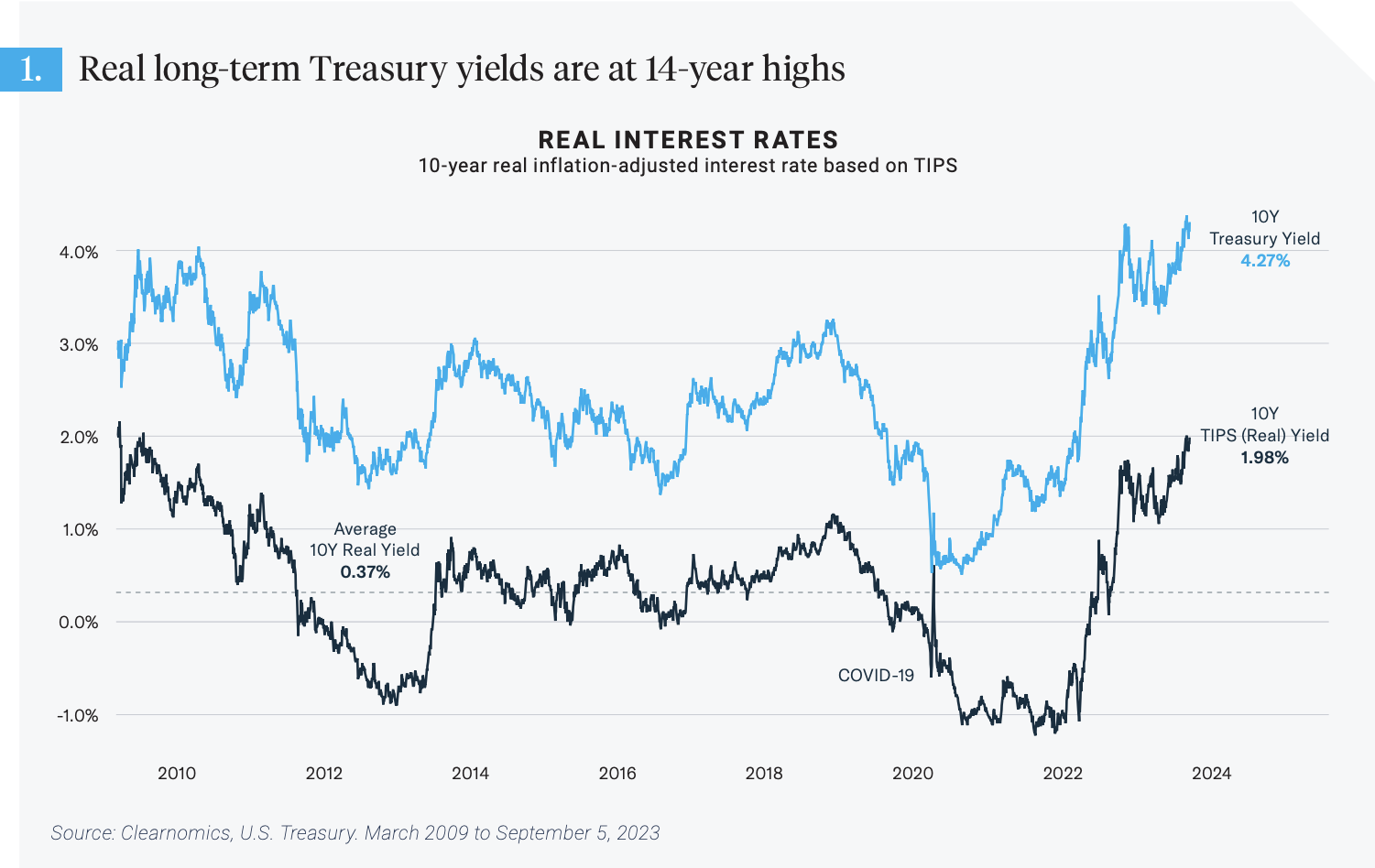
What Rising Real Yields Means for Investors
Long-term interest rates have come full circle over the past year. After falling as low as 3.3% during the banking crisis earlier this year, the 10-year U.S. Treasury is now yielding around 4.2%. However, while today’s long-term yields look similar to last year’s on paper, they are quite different from an economic and market perspective. What are interest rates telling us today and how does this impact long-term investors?
An important concept in economics is the distinction between “nominal” and “real” values. The simplest way to understand the difference is that nominal values include the effects of inflation while real ones do not. For instance, the price of a gallon of milk at the grocery store is a nominal price since it changes based on inflation. The paychecks we receive are also nominal values since they are paid in dollars or other currencies whose purchasing power changes as the prices of goods and services fluctuate.
A real value, on the other hand, represents the actual amount of goods and services one receives, irrespective of the prices of those items. A gallon of milk, for instance, is still a gallon of milk whether it costs $3.97, as it does today on average across the country, or $2.84 as it did five years ago. If someone were to receive their paycheck not in a set amount of nominal dollars but in the real dollar equivalent of gallons of milk, i.e. an amount that allows them to buy a set number of gallons, they would receive more dollars today. In this way, their paycheck would be protected from inflation, at least in terms of milk.


Why does this matter? When prices are fluctuating, such as in times of high inflation, it’s helpful to understand what we’re actually getting for those prices. This distinction between nominal and real values is important for investing as well. For example, the 4.2% yield on 10-year Treasury securities is a nominal yield. When inflation rises faster than expected, the actual purchasing power of the interest payments an investor receives will be lower, and vice versa. Thus, the real yield one receives depends on the level of inflation and is what should matter to long-term investors. Similarly, investing in stocks has been historically attractive because stock market returns have far outpaced inflation, resulting in positive real returns.
Fortunately, even though the nominal yield on the 10-year U.S. Treasury appears to be the same as it was last year, the real yield is now at its highest level since 2009. This is because inflation expectations have improved dramatically, as shown in the accompanying chart, and economic growth has surprised to the upside. What’s more, the current real yield of 1.9% is far above the average since the global financial crisis of 0.37% when both nominal interest rates and inflation were low. This is another reason that bonds continue to be attractive and important components of diversified portfolios despite the significant volatility of the past two years.
These concepts affect stock market valuations as well. When real yields on bonds are higher, investors may find it more attractive to invest in bonds than riskier stocks, at least on the margin. In other words, the bar for stocks is higher when investors can generate attractive real yields from bonds. The difference between the stock market’s earnings yield and the real yield on bonds is often referred to as the “equity risk premium” since it represents the premium investors receive for taking equity risk.
Thus, there can be an inverse relationship between higher real rates and stock market valuations in the long run. In the short run, other factors can be more important such as the rally in tech this year. At the moment, the S&P 500 earnings yield of 5.3% is below its historical average of 6.7% and is even lower when adjusted for the level of either real or nominal interest rates.
Of course, this does not mean that the stock market is not attractive for other reasons or that investors should only hold bonds. As always, long-term investing is about building diversified portfolios that contain the proper allocations of stocks, bonds, and other asset classes depending on financial goals. The fact that real long-term treasury yields are at their highest level in 14 years is one factor for investors to consider as they structure their investment portfolios to increase the odds of financial success.
Indexes are unmanaged and it’s not possible to invest directly in an index. The ICE BofA Move Index measures treasury volatility through options pricing. The MSCI Europe Banks Index is composed of large- and mid-cap stocks classified in the Banks industry group within the Financials sector across 15 developed market countries in Europe. The S&P 500 Total Return Index is a market-capitalization-weighted index of the 500 largest U.S. publicly traded companies. The S&P 500 Banks Industry Group is comprised of bank constituents from its parent index, the S&P 500 Index.
Carefully consider the Fund’s investment objectives, risk factors, charges, and expenses before investing. This and additional information can be found in Amplify Funds statutory and summary prospectus, which may be obtained above or by calling 855-267-3837, or by visiting AmplifyETFs.com. Read the prospectus carefully before investing.
Investing involves risk, including the possible loss of principal. Shares of any ETF are bought and sold at market price (not NAV), may trade at a discount or premium to NAV and are not individually redeemed from the Fund. Brokerage commissions will reduce returns. It is not possible to invest directly in an index.
Amplify ETFs are distributed by Foreside Fund Services, LLC.
Carefully consider the Funds’ investment objectives, risk factors, charges, and expenses before investing. This and additional information can be found in Amplify Funds statutory and summary prospectus, which may be obtained by calling 855-267-3837 or by visiting AmplifyETFs.com. Read the prospectus carefully before investing.
Investing involves risk, including the possible loss of principal. Shares of any ETF are bought and sold at market price (not NAV), may trade at a discount or premium to NAV and are not individually redeemed from the Fund. Brokerage commissions will reduce returns.
Amplify ETFs are distributed by Foreside Fund Services, LLC.


